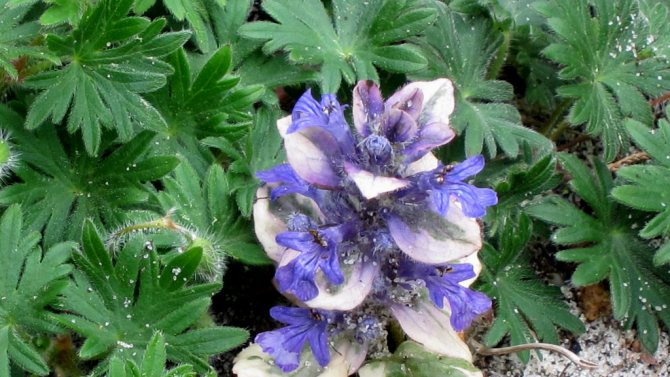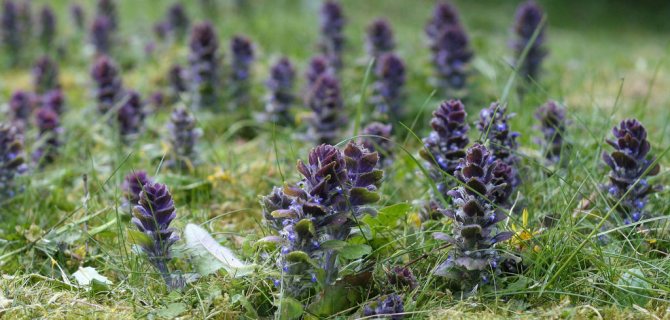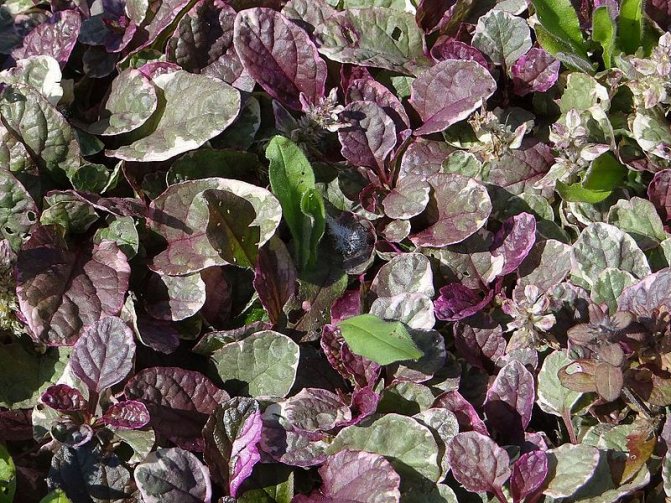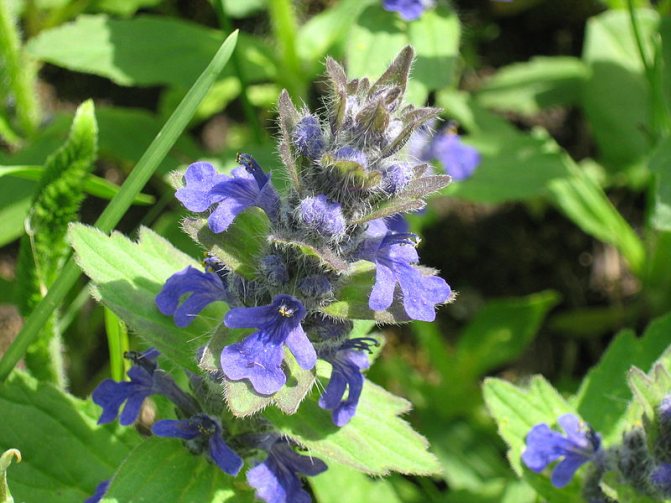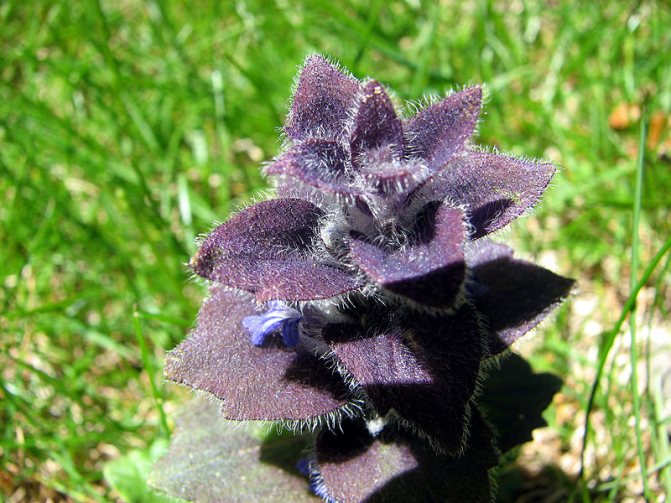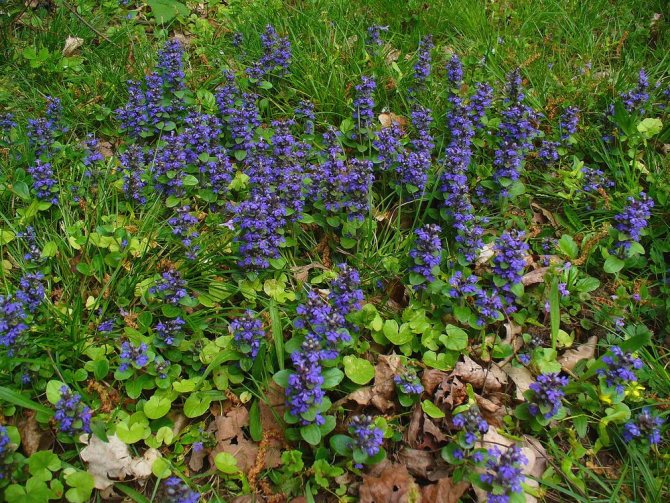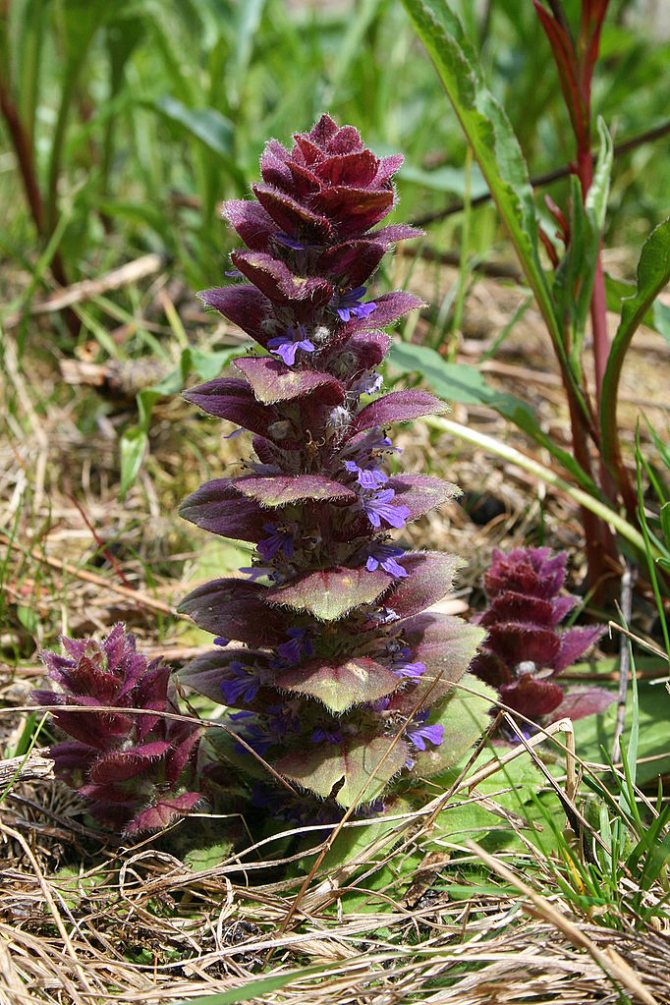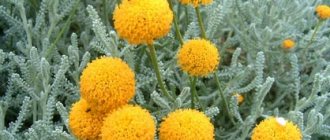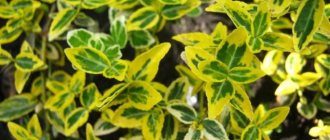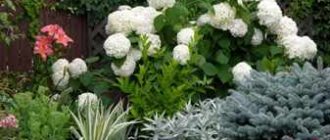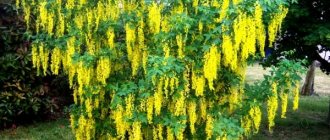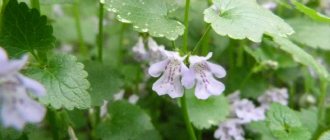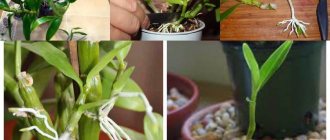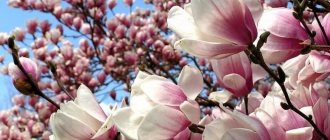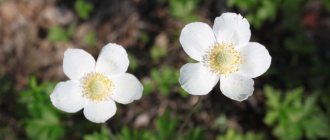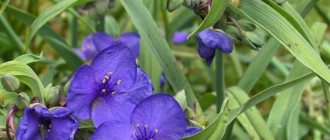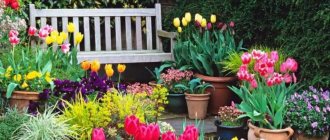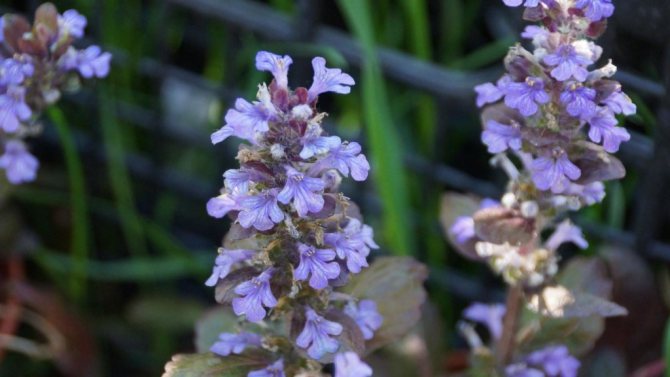
Tenacious creeping, or Ayuga, is an ornamental-leaved groundcover perennial plant from the Lamiaceae family, up to 20 cm high, with creeping shoots rooting in the leaf axils and erect peduncles. From the name it becomes clear that, firstly, the resistance of this plant to all the hardships of life (be it drought, bad soils, lower temperatures, waterlogging, frosty winters) can only be envied, and secondly, with the chosen method of movement, the tenacious creeping can spread through your garden completely unaided. The tenacity is good and indispensable if you need to close a bare soil area in a short time with minimal labor costs, while pursuing decorative purposes.
In gardening, the tenacious has been used since the middle of the 17th century; this plant is great for decorating alpine slides, as it grows well on the slopes, filling all the voids between the stones. An excellent lawn will come out of a creeping tenacious, usually it is planted in places where lawn grass does not grow - in shady places or under tree crowns. The tenacious can be combined with low-growing perennials or in the foreground of tall plants, a ground cover plant with decorative leaves will create the necessary background for beautiful flowers.
The creeping tenacious remains decorative throughout the season thanks to its beautiful leaves, they can be monotonous green, bronze or purple in color. If you use several varieties of tenacious with different leaf colors, then a leaf carpet on the ground will not look monotonous and boring.
Ayuga (Ajuga) belongs to the family of labiates, the genus has about 40 species of plants that can be found in various parts of the world from Europe to Australia. This is a perennial rhizomatous plant with creeping shoots that take root along the entire length, in contact with the ground, thanks to this quality, the plant grows rapidly in all free directions. In height, the tenacious does not exceed 20-25 cm. Lobed leaves can be interesting colors not only monotonously green, there are varieties with variegated leaves with cream, pink and light green stripes.
The tenacious bloom in the first half of summer. On low straight peduncles, in tiers, whorls with small leaves and sitting spongy flowers are located - blue, pink or white. The bloom of the tenacious lasts 1-2 weeks.
Description of the plant
Creeping insect (Ajuga reptans) or Ayuga - a perennial herb, belongs to the Lamiaceae family. Heights up to 20 cm, erect peduncles. The flowers are small, white, blue, blue and pink are found. The plant belongs to the ground cover, as its leaves are creeping, take root in the axils. One of the characteristic features is the absence of root growth, which makes it easier to care for it.
Ayuga is ubiquitous: it is found practically throughout Europe, in the European part of Russia, in the Caucasus, in Turkey, Iran and even in the countries of North Africa: in Algeria and Tunisia. It grows both in forests (usually deciduous), and in glades and forest edges, among bushes, which indicates unpretentious care.
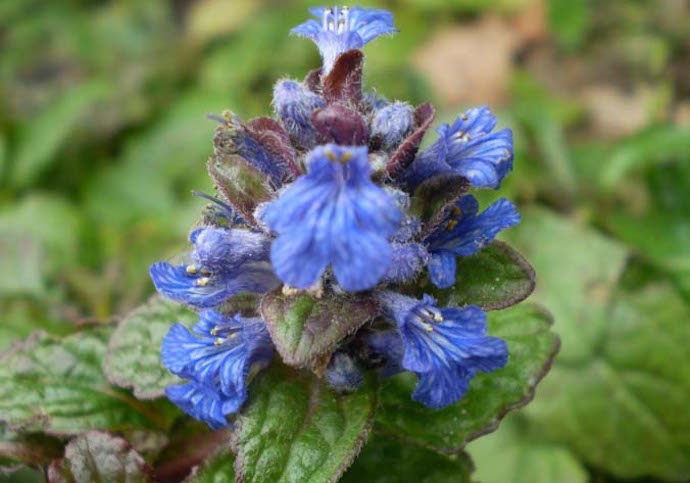

Description of the species
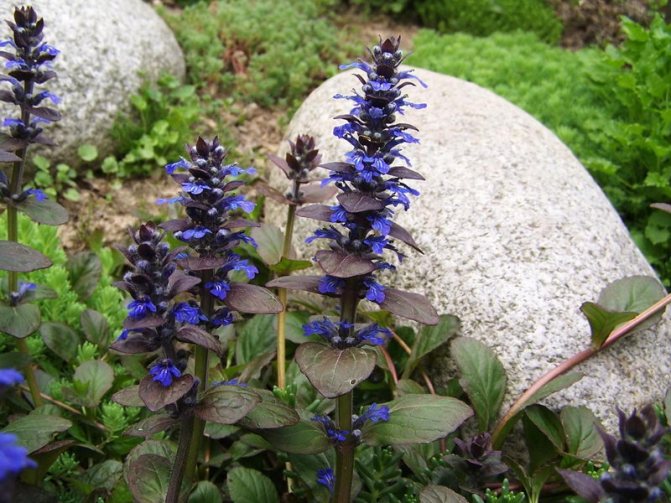

Ayuga tenacious creeping planting and care photo of flowers
The plant is erect stems from several to 40 centimeters high, on the stems below, large leaves are decreasing opposite to the top. Flowers can bloom in blue, purple, dark blue, yellow flowers, which are collected false whorls. This species is very unpretentious to growing conditions; no special conditions for care are required. The plant can fill the provided area with a solid carpet and is used for landscape decoration in mixborders, rock gardens, rockeries, ground cover lawns.
Varietal variety
Today, there are about 45 species of Ayuga, which can be found in different parts of the world. Initially, the plant was remembered for its bright blue flowers, but the breeders did not stop there and bred different varieties. So today a wide selection of creeping tenacious is presented: gardeners have achieved not only a change in the color of the flowers themselves, but even the leaves.
- Atropurpurea (Ajuga reptans Atropurpurea) - according to the description, this species has leaves of an unusual purple-brown color, the flowers are dark blue. Usually grows up to 15-20 cm in height. With proper care, it blooms actively from May to June.
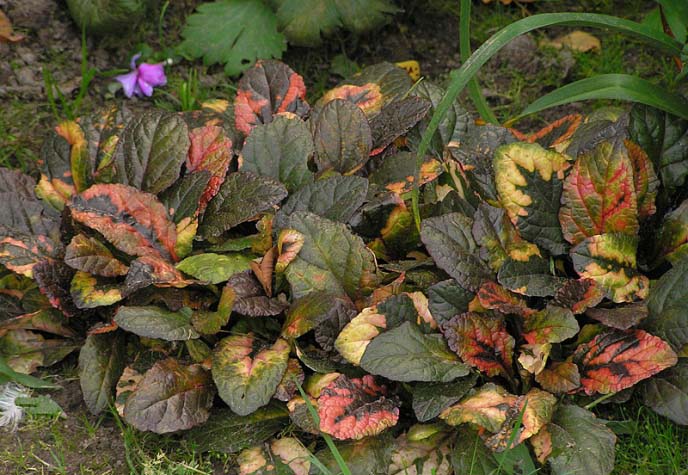

- Multicolor (Ajuga reptans Multicolor) - the peculiarity of this variety is the leaves. At first glance, it may seem that the plant is all burned, but this is not so. In fact, its leaves are not monochromatic, but spotty: yellow, pink, light green spots are visible on a dark green leaf. Flowers are dark blue.
- Variegata (Ajuga reptans Variegata) - in this variety, the leaves are bordered by a creamy white stripe, by themselves they are more rounded, rather than elongated. Minimal care is required.
- Chocolate Chip - this zest has the smallest leaves (only 3-4 cm in length), and their color is unusual - chocolate brown. Peduncles are low, but close to each other.
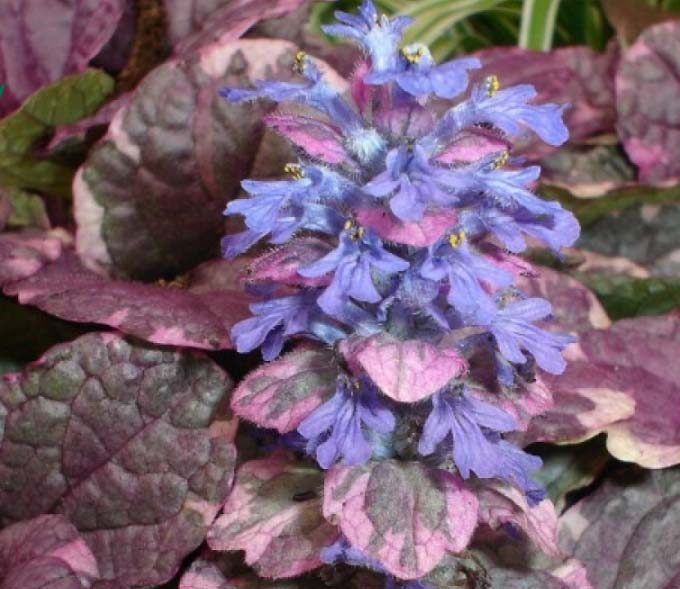

- Burgundy Glow (Ajuga reptans Burgundy Glow) - the color of the leaf of this variety of tenacious can not be found in any other plant. The center of the leaf is green, smoothly turning into a lilac-crimson border, and the edges of the leaf are pinkish-white. In addition, flowers can be of different colors.
- Black Scallop (Ajuga reptans Black Scallop) - this variety has large wavy leaves with jagged edges, brown in color.
Varieties of creeping tenacious
Tenacious Burgundy glow
Recognized as the most attractive variety due to the variable color of the foliage. She can combine pink, burgundy, reds and greens. The most common are reddish green leaves with a lighter border around the edge, or pink leaves with a white border. As they grow, the color of new plants may change.
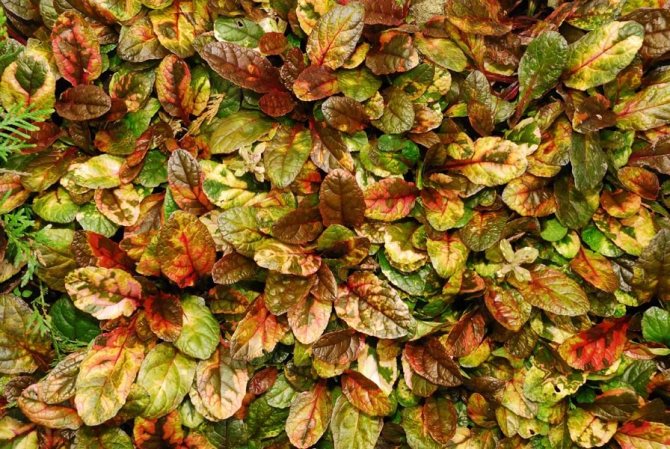

Tenacious variegata
The leaves have an uneven "marble" color, consisting of cream, silver, green and gray shades. Loses attractiveness if it lives in bright light. It grows slowly, usually used to decorate alpine slides.
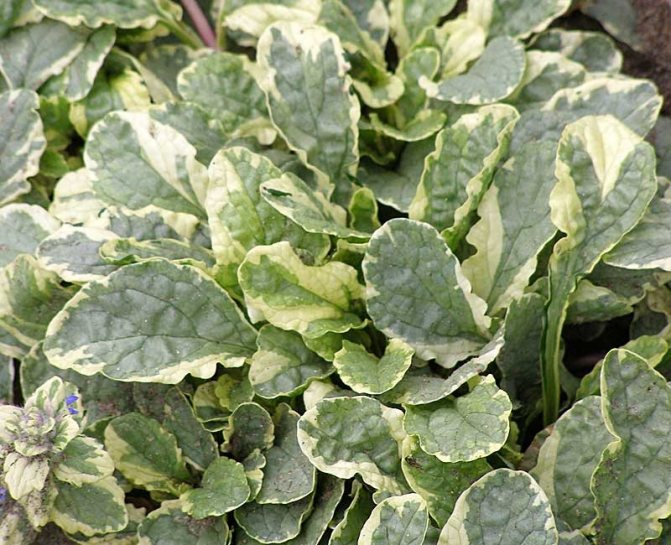

Tenacious Atropurpurea
An upright plant with burgundy purple leaves. Small compact bushes grow quickly to form lush rugs.
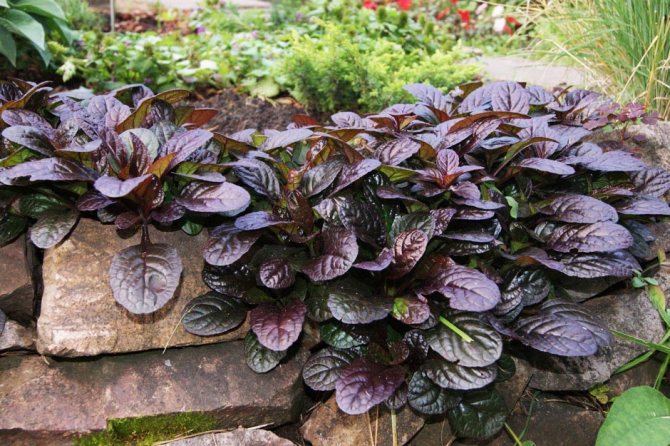

Tenacious Multicolor
A view with amazingly picturesque leaf color. On a dark purple or burgundy background, strokes of yellow, pale green and pink shades are scattered.
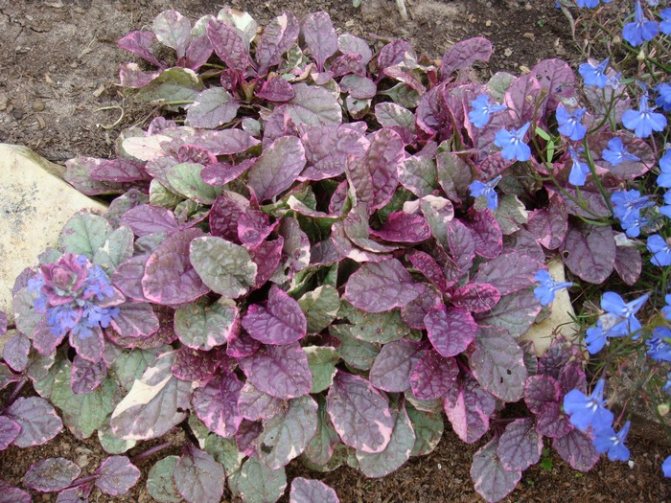

Zhivuchka Chocolate chip
The leaves have a narrow and elongated shape, which is atypical for tenders, and are colored chestnut. A very undersized variety that grows rather slowly. Possesses bright blue inflorescences.
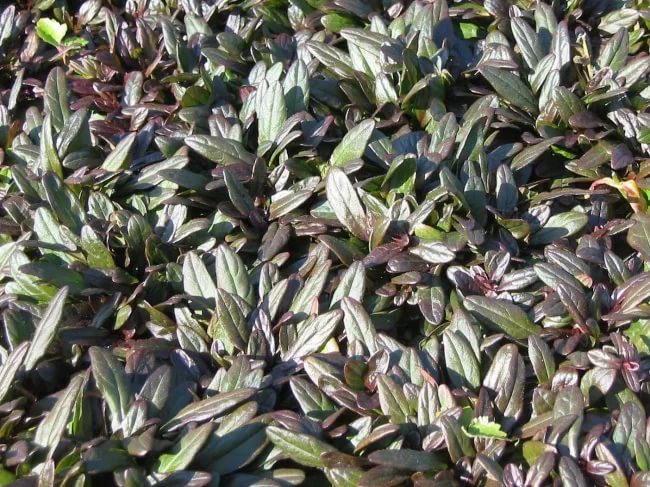

Tenacious black scallop (Black scallop)
The leaves are deep purple in color and glossy. When grown in bright light, they turn almost black. Inflorescences are blue.
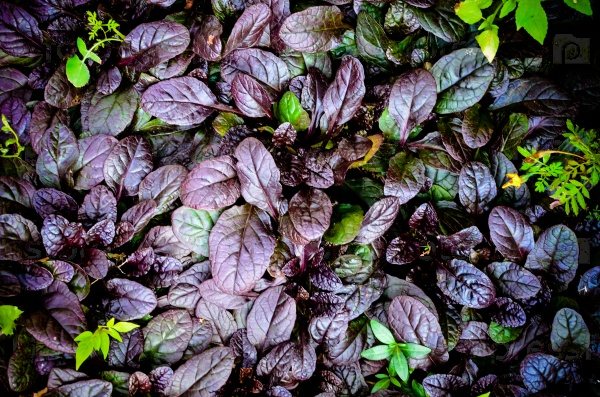

Tenacious Variegata rubra
The most typical variety with all the characteristics of the initial species. It has bluish-blue inflorescences and chestnut-red leaves.
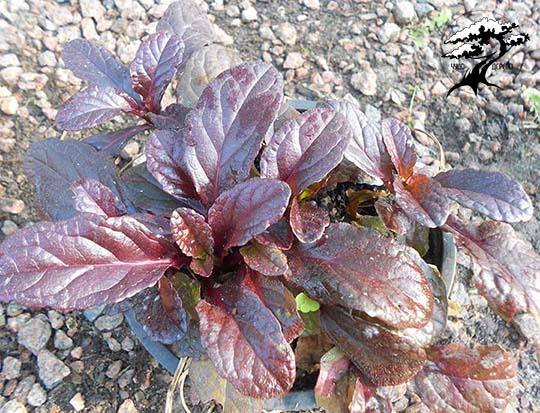

Catlins giant
The tallest variety with large leaf blades and elongated peduncles.
How to plant a tenacious
You don't need any special skills to plant an Ayuga.This plant is so unpretentious and tenacious that no matter how inept you are in gardening, it will still germinate.
- The creeping insect grows well in full shade and light (but still try to avoid areas with direct sunlight). Will grow well under bushes.
- She thrives on any soil, but prefers loam and sandy loam.
Planting and breeding Ayuga (video)
- Needs at least a minimum amount of rainfall. Can withstand drought for up to a month. But it is necessary to water the newly planted seedlings or seeds for at least the first week. They need good care at first.
- Do not plant the tenacious in places where animals may walk or walk on it. This plant is very sensitive to mechanical stress. The fragility of the stems is noticeable even in the photo.
Breeding and planting
The creeping insect reproduces in several ways:
- seeds;
- vegetative - dividing the bush (rhizome).
Seeds it is better to buy plants in a specialized store, since they have a high germination and properties of the variety. But you can also use the seeds collected after the flowering of the plant.
It is necessary to sow seeds in open ground in spring, when the ground is well warmed up. The most suitable soil for a tenacious is loam, but garden soil is also suitable. The place is selected depending on the design and purpose of planting. Ayuga will grow well both outdoors and in the shade of a tree.
Important! You can sow seeds not only in spring, but also in autumn, when winter is approaching. Then in the spring, at the first rays of the sun, the plant will begin to grow actively and bloom earlier.
It will look especially beautiful in the root system of trees, which is often done, since the plant does not take nutrients from the tree.
Before sowing, the land is well cultivated, organic fertilizer and mineral fertilizer or superphosphate are introduced into it.
Shallow holes are made in the soil, where several seeds are laid. Sprinkled with earth and watered well.
They germinate for about 2 weeks, but the subsequent growth is much faster.
In case of landing seedlings, bought in a store or grown at home, the distance between the bushes - sockets should be at least 30 cm.The planting time is mid-late May, but in the southern regions it is possible even earlier, since the plant tolerates short-term frosts down to -10 degrees. Seedlings are especially fond of good watering ...
During the period of active growth, May-September, the plant can reproduce division... The bush must be dug out, carefully separated from one of the stems from the root and immediately planted in a new place. This can be done repeatedly as the plant grows.
Important! With the method of reproduction by dividing the bush, the plant does not lose varietal characteristics.
How to take care of a tenacious
Ayuga care will not cause any particular difficulties:
- Water several times a month.
- Every spring, it is advisable to apply a universal top dressing to the soil.
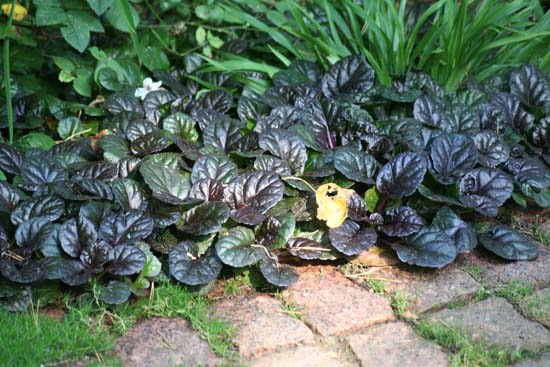

- If you do not want the plant to grow, then simply weed it out, removing excess shoots. Fortunately, there are no pitfalls in the form of hard-to-reach roots.
- Of the pests of Ayuga, only slugs and garden snails, who love to feast on juicy foliage, are worried about. However, it is very easy to get rid of them: pour the soil with lime solution, and uninvited guests will leave.
Useful properties of the plant
A tenacious flower for decorative purposes is used in landscape design. It is planted to cover the ground in parks, squares, gardens, alpine slides, slopes are made out, and it also serves to fill the voids between tall perennials and shrubs. Suitable for organizing hedges.
For medicines in traditional medicine, leaves and flowers are used. The composition contains tannins, essential oil, alkaloids, steroids, phytoecdysones.They have anti-inflammatory, diuretic, astringent, tonic, healing properties. Inside, decoctions and infusions are used to treat cough, strengthen the immune system, against temperature. Outwardly used for the treatment of rheumatism, skin diseases, as well as for rinsing the mouth and throat, with diseases of the gastrointestinal tract. Young leaves located in the root zone are edible. They can be used to fill fish dishes, salads, cook soups with them.
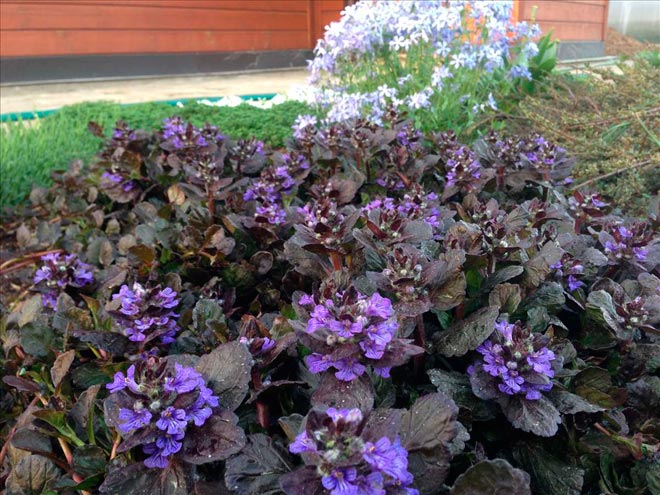

Reproduction of the tenacious
The flower culture propagates by seeds and daughter rosettes. Moreover, it is the second method that is most often used. It is also the simplest:
- separate the required number of cuttings from the mother plant;
- plant them in the soil about 20 cm apart;
- do not forget about watering at first;
- you can plant a flower from May to September.
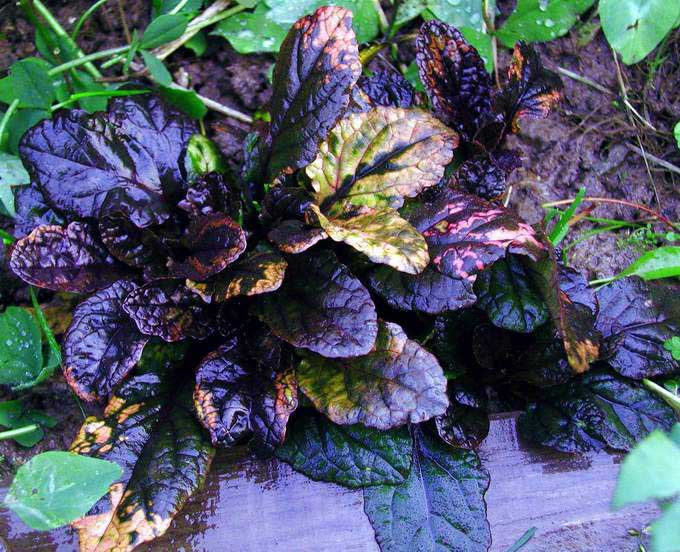

It should be noted that only vegetative propagation (by shoots) will ensure the preservation of decorativeness.
Planting and caring for carpet flowers
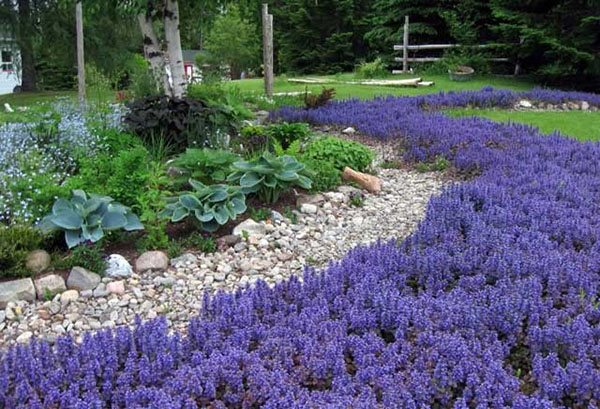

To grow a flower carpet on a personal plot, it is important to follow the basic rules for planting a creeping tenacious and caring for it.
The plant propagates by sowing seeds or dividing bushes. But, first, you should prepare the soil and choose a suitable place in the garden. Since Ayuga is an unpretentious plant, it will take root anywhere in the flower garden. However, in a shaded area, the survivor will be better.
The ideal soil for planting a plant is loam, which is enriched with vermicompost. In the prepared small holes, the seeds of the tenacious are sown and sprinkled with earth.
Sowing material is best purchased in special stores. Seeds that are harvested on their own lose varietal characteristics.
You can plant a creeping tenacious in a vegetative way. To do this, the root of the plant is divided into stolons, in which there are 3 internodes. To get planting material, the tenacious is actively watered for about a week. During this time, new roots grow. The plants you like are dug up, and then, divided into parts with a sharp knife or scissors. New seedlings are laid out in the prepared hole at a distance of 30 cm from each other. Covering them with earth, the main thing is not to cover the top of the plant. It is possible to plant a creeping tenacious in this way in the spring, while it has not bloomed.
It is interesting: Flowers "Lupines": planting, growing and care, photo
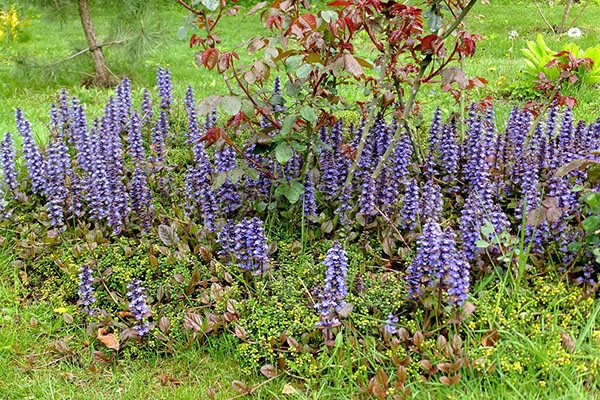

You can plant a flower carpet by dividing the plant into rosettes. There should be 3 of them on each handle. Thanks to this, the creeping tenacious will take root faster. This method is applicable during the entire warm period.
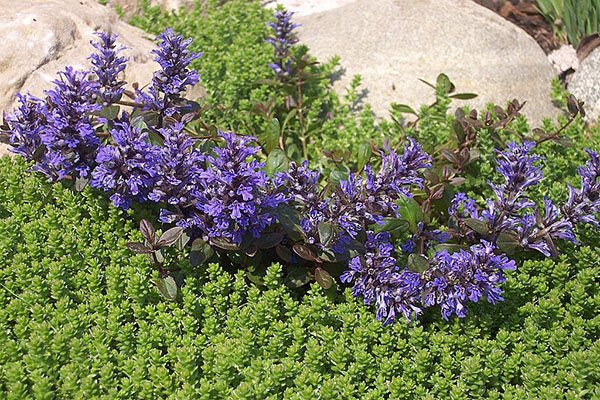

The main rule of Ayuga care is to control the growth and density of the carpet. In view of this, it must be periodically thinned and watered during a drought. If the flower pillow has been pleasing to the eye in one place for more than 6 years, nitrogenous fertilizers must be applied to the soil. And in early spring, add a little soil.
In winter, the tenacious can not be covered, since it is not afraid of frost.
The use of tenaciousness in landscape design
Tenacious is an ideal ornamental plant, very often used in landscape design. It also works great as a photo backdrop.
- Look great in flower beds.
- Feels good on slopes, among stones.
- For her, border plantings along the paths are suitable.
- She will become an excellent resident of the rock garden.
- Will look great in the foreground in a flower garden.
- It looks great in a composition of conifers.
- It is appropriate to plant the plant on the shore of a reservoir, under tall plants.
- Since it is an evergreen plant, it is also suitable for a winter garden.
- It can be grown in commercial or self-made containers.
- The tenacious can successfully plant hard-to-reach shaded places (near-trunk circles, corners of fences).
- Due to the fact that the plant has medicinal properties, it will perfectly take root in medicinal flower beds.
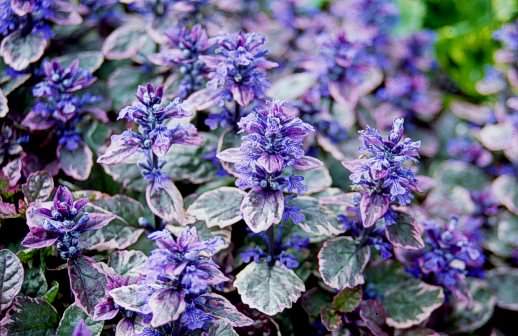

Beneficial features
The plant has useful qualities and is used as a folk remedy. It possesses:
- hemostatic;
- bactericidal;
- diaphoretic;
- expectorant;
- diuretic;
- astringent;
- wound healing;
- anti-inflammatory action.
With the help of fresh juice, burns are treated, it destroys germs and bacteria.
For herbal medicine, the stem and leaves of the culture are used. Its juice contains ascorbic acid, vitamin K, flavonoids, steroids, tannins and essential oil.
Compatibility with other plants
Due to the unusual and non-uniform color of the leaves, it is better to plant the tenacious next to monochromatic plants. It should also be remembered that Ayuga is classified as an aggressor plant (it easily conquers territory from small flowers), so it is better to choose plants as neighbors that can “defend” their territory. The tenacious goes well with the following plants:
- ferns;
- iris;
- rudbeckia;
- loosestrife;
- delphinium.
If you don't have Ayuga in your garden yet, correct this mistake immediately! As you can see, this plant gives only pleasure: for its beautiful appearance, and ease of grooming and reproduction, and wide compatibility with other plants. By planting a tenacious plant, you will acquire the most unpretentious and one of the most beautiful inhabitants of your flower garden!
Diseases and pests
The tenacious is very resistant to all kinds of diseases, however, due to waterlogging, fungal diseases can develop that cause rotting of the roots and stem. From this, the plant stops growing and blooming, does not release daughter shoots. The leaves begin to turn yellow and fall out. When damaged by root rot, the rhizome has an unpleasant gray bloom with brown blotches. You can deal with the problem with the following methods:
- It is advisable to remove all infected parts. Sections are processed with crushed charcoal.
- A healthy rhizome is treated with fungicides, for example, Topaz, Champion, Bordeaux mixture.
Description of an unusual Ayuga flower with a photo
Blooming plants of the tenacious are very rare, but the tenacious does not need flowers: it spreads well by shoots on which young rosettes grow. Often these "babies" grow up next to their "mother", but sometimes the shoot passes between the leaves so that the "baby" is sitting on the mother's socket. Growing up enough, she falls to the ground. Sometimes this comes from some accidental jolt: either a drop of rain, or a blow from the foot of a passer-by, or a pine cone that has fallen from a pine tree, etc., makes the young rosette detach from its mother. Having fallen to the ground, the outlet, of course, does not always turn out to be in the proper position - with the bottom to the ground; it can lie on its side, or even completely upside down. It was then that she begins to act like a beetle, although incomparably slower. If the rosette lies sideways, its lower leaves are shaded and, as a result, begin to grow vigorously. These leaves, acting like the beetle's elytra, rotate the rosette to its normal position.
If the rosette of the flower of the tenacious has fallen upside down, the rotation is made with the help of roots acting like the legs of a beetle. The root, embedded in the ground, pulls in its direction and makes the socket turn. If two or three roots are pulled at the same time, the turn is in the direction of the "resultant force". If the roots are accidentally pulled in opposite directions with the same force, the rosette cannot turn and the plant dies.
If you get a few young tenants, you can trace all the details of the described phenomena. To do this, you need to put the rosettes in different positions on the wet sand in some plate and put this plate somewhere in the sun. A complete turn of the rosette is performed sometimes in a week, and sometimes only in three weeks, much more slowly than a beetle.
It is strange that the botanists were rejuvenating or hard-hitting for unusual turns for a long time.All the more great is the merit of our Soviet botanist N.G.Kholodny, who, ten years ago, thoroughly investigated and perfectly described this curious feature.
Among the tenacious plants are evergreen, semi-evergreen, deciduous. The most common in floriculture are decorative deciduous, ground cover perennial ayugas with creeping stolon shoots rooting in the leaf axils.
Blooms in May - June.
Reproduction
You can propagate a tenacious animal in different ways.
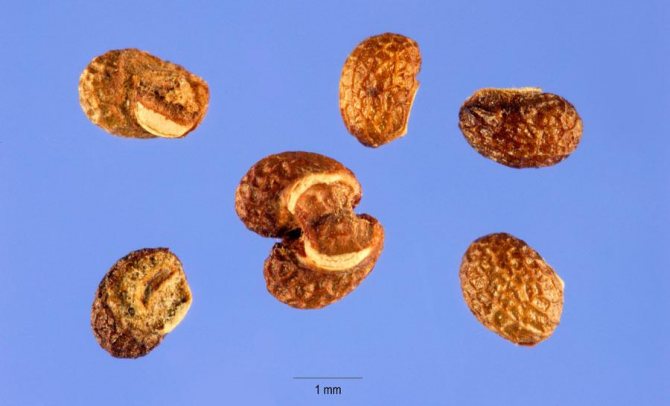

Seeds
Breeding in this way is not the best option, it is suitable only for those who are just starting to practice hardiness and do not have adult bushes to get outlets. If there are such plants, and you still decided to take ripe seeds from them, be prepared for an unexpected result. Ayugs obtained from them are unlikely to correspond to the description of the variety.
Vegetatively
Breeding in this way should be left for March or the first quarter of September. The sockets that managed to appear on the mother plant are cut off and planted in the place where they will already grow constantly. You can get many new bushes, because it does not matter if the roots of the cuttings are dense, you can take those with one root.
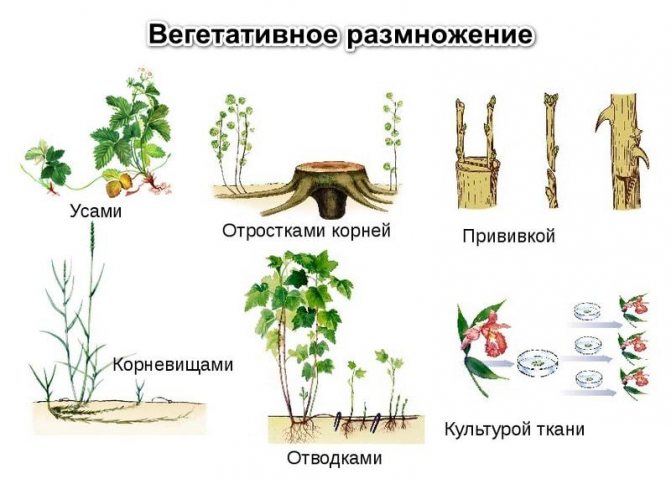

Choosing a place for planting a tenacious
Actually, this question in relation to this completely unpretentious plant is not at all fundamental. It can grow in an area completely open to the midday heat and can even tolerate dense shade. The situation is the same with the soil question. Ayuga puts up with heavy, and with loose, and waterlogged soils. But, if there is an opportunity to choose, then she will more like nutritious, humus-rich areas, moist loam and shimmering, sliding shadow.
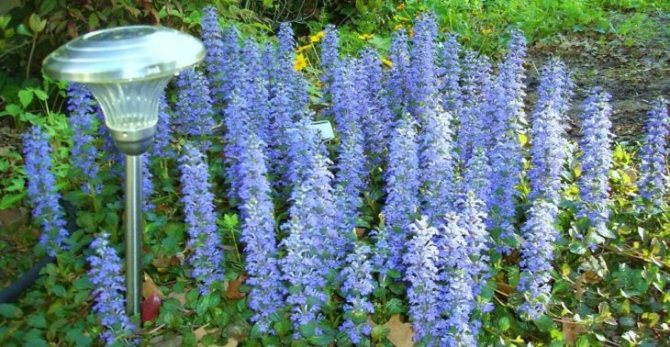

Possible growing difficulties
The plant is frost-resistant, so even a high snow cover is not afraid of it. Special preparation for wintering is not carried out; additional shelter with dry leaves or spruce branches will help to survive the winter in those areas where at this time the temperature drops below -20 degrees.
The shoots planted this year must be covered without fail, since their root system and stems are not yet strong enough to survive the cold.
Ayuga can oppress neighboring plants. In the absence of shoot removal, it behaves like a weed. You should not plant low creeping crops next to it, which require a lot of space and light.
If you use varieties with flexible soft trunks, you can organize an ampel composition. In this case, the tenacious is immediately planted in hanging pots or flowerpots.
Types and varieties with photos
Among the varieties of the tenacious, there are evergreens, and deciduous, and representatives of the intermediate class.
Herringbone tenacious
A very undersized species, spreading with a carpet up to 6 cm. It has gray-green leaves with jagged edges, in appearance resembling the scales of a husked pine cone. The similarity is complemented by a pleasant light coniferous aroma. It blooms with yellow flowers for a very long time, from spring days to late autumn. Loves light and fairly dry soils, responds extremely positively to organic matter and mineral complexes. In relation to neighboring crops, it is slightly aggressive.
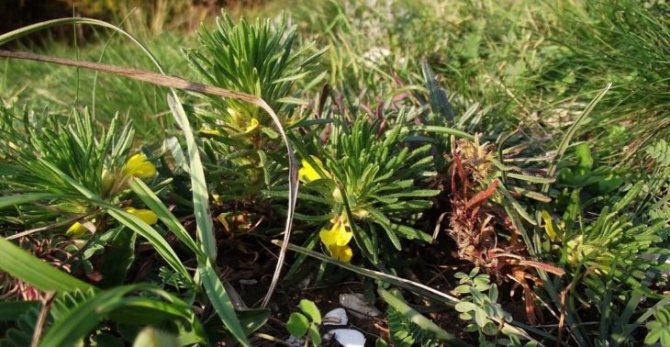

Tenacious of Geneva
A more southern variety, it is ubiquitous in the Crimea and in the Caucasus region at an altitude to the middle of the mountain ranges. The root system is very superficial and extensive. The height of densely pubescent shoots can vary greatly from creeping squat to 30-40cm. The lower short-petiolate leaves form a dense rosette, on the shoots the leaves are sessile, have a different, obovate shape with a dissected-toothed edge. Blooms from May to June, but can generate foliage twice and bloom again. This species is not prone to spreading over the site and does not require control and strict territorial restrictions.
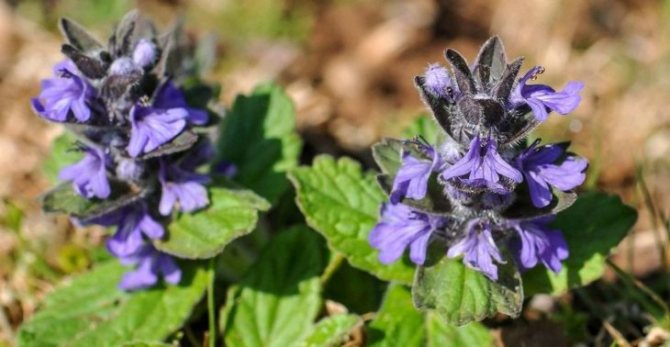

Interesting fact.Ants take part in the natural reproduction of the tenacious.
Pyramidal tenacious
This type of culture comes from Europe, where it grows even in poorly passable places and on very poor rocky soils. An extremely unpretentious perennial in care. It has an external resemblance to a creeping species, but less tall, does not exceed 25 cm. It also differs in that it does not form continuous coatings. The shoots have a very dense pubescence, and the leaves also have a fleecy surface. The flowers of the selected varieties can be bright blue, white or beautiful pink.
The most popular variety is "Metallica Crispa" with very decorative, highly folded leaves of a bizarre arachnoid shape, casting a metallic sheen.
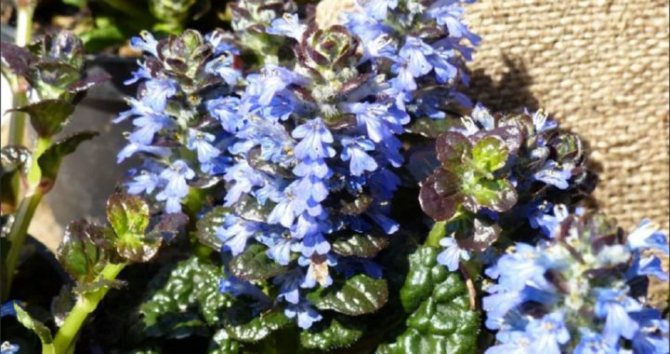

Tenacious creeping
The most famous species in Russia, it grows in many other European and Asian countries. Loves wet meadows, mixed forests and even bushy thickets. The root system is racemose, fibrous, creeping; shoots take root easily and give new leaf rosettes. The stems have soft matted pubescence. The lower basal leaves are narrowed, sit on elongated petioles, the upper stem leaves are sessile, their petioles are very short. The third type of leaves - bracts, have a solid shape and often turn blue at the base. It is a polymorphic variety with a short flowering period of about 20 days from May to June.
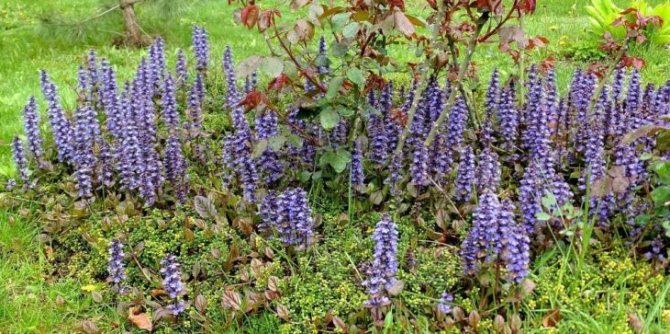

The most decorative breeding varieties with photos
- "Atropurpurea" - leaves with a bronze-brown tint, strongly wrinkled. Forms dense and dense clumps up to 8 cm high. The most sun-loving variety among others. It can grow in relative shade, but it will be less beautiful.
- "Burgundy Glow" - attractive for its variegated leaves, the diversity of which depends on the characteristics of the soil and light. The color of the foliage may contain reddish and lilac notes. Prefers semi-shaded places.
- “Black Scallop” has glossy, highly decorative leaves.
- Multicolor is another variety with variegated foliage.
The tenacious can grow for a very long time in one area, since it is practically not subject to degeneration and overgrowth like many other ground covers.
What species grow in nature
Ageratum - growing from seeds, care and planting
In their natural habitat, there are about 70 species of tenacious.
Geneva
The tenacious geneva, or shaggy, reaches a height of 50 cm. The upper leaves are elongated or ovoid, the lower ones are crenate-toothed. The flowers are blue or pink. Inflorescences are collected in whorls of 2-5 pcs. The stems of this species do not grow. Flowering occurs in April-July.
Most often found in the European part of Russia, Ukraine, Moldova, Belarus and the Caucasus. The most popular variety of this species is the tenacious Genevan Helena. It is a perennial that grows up to 50 cm in height.
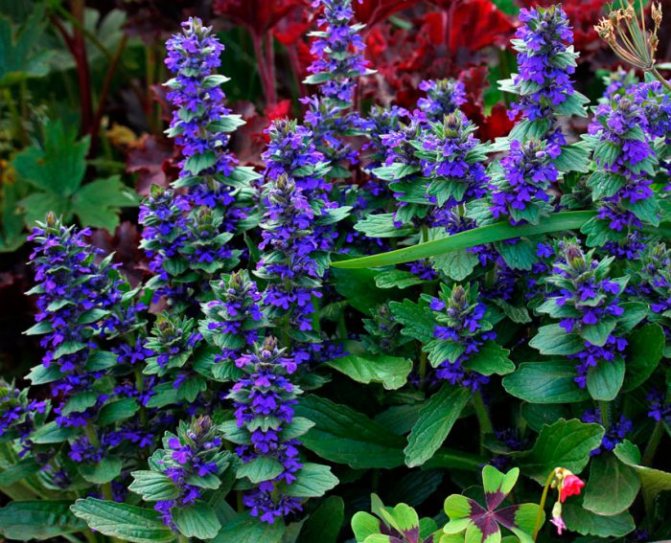

What does a geneva tenacious look like
Chios
Chios tenacious is common in the Caucasus, Iran, the Mediterranean. The species mainly grows on rocky terrain, roadsides, embankments. In height, it can stretch no more than 20 cm. Shoots are erect. They are covered with white villi. The leaves are spatulate below, and three-toothed above. The flowers are in the shape of a false spike and are located at the ends of the shoots. They are yellow in color.
For your information! The gruel from the shoots promotes faster wound healing.
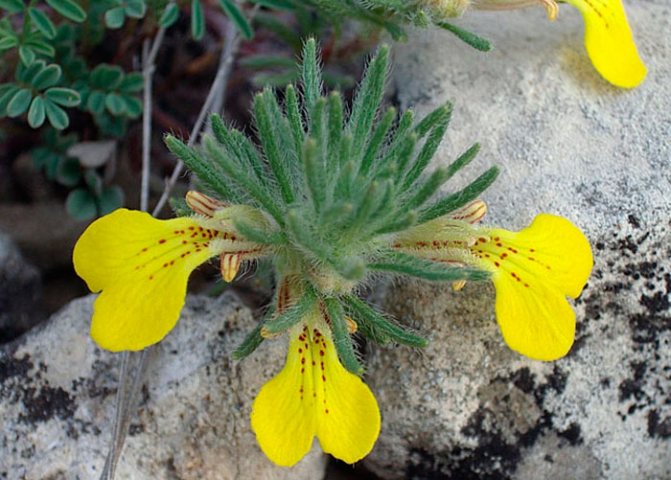

What does the Chios tenacious look like
Pyramidal
The pyramidal type began its existence in Europe. It can grow in rocky areas and among bushy plants. It reaches a length of up to 25 cm. The leaf plates are similar to an oval. There is a long pile on them. Flowers grow up to 10 cm. They can be white, pink or purple. There are several varieties of this type:
- Lunar Landing. These flowers are yellow in color.The variety was bred by the botanist F. Riotto;
- Crispus. The leaves on the bush are large and compressed. They are greenish in color. The petals are blue;
- the tenaciousness of Metallica Crisp. The bush grows up to a maximum of 5 cm. The leaves are small green in color with a sheen of metal.
Shaggy
Height up to 50 cm. Lilac flowers. The species is common in Russia, Ukraine and Belarus.
Eastern
The eastern species grows up to 10-20 cm. The leaves are wedge-shaped. Flowers in a blue tone. Bracts have a blue tint.
Laxman
The height of the bush is 0.2-0.5 m. There are drooping leaves on the shoots. The entire leaves are large and silvery in color. The flowers are small. They are light pink and light yellow.
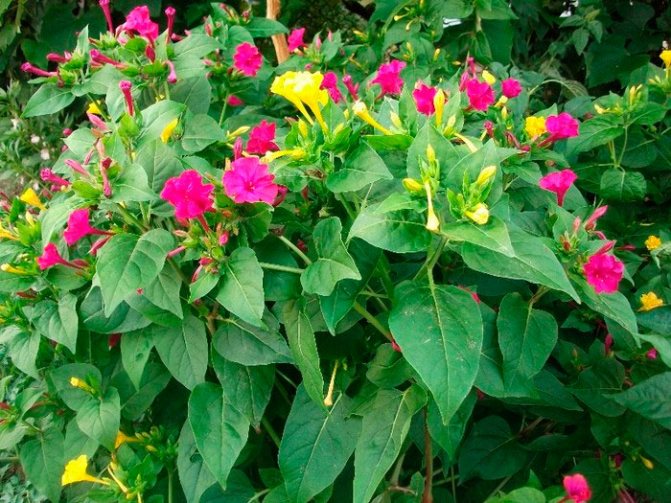

Laxman's view
Herringbone
It grows only up to 6 cm. The leaves have a green-gray tint and serrated ends. They look like bumps. Flowers are yellow.
Turkestan
It grows in Uzbekistan and Tajikistan. The small number of branches is the main feature of this species. The shoots are thick. They have elliptical leaves. The leaves are brown. The flowers are purple. The plant has medicinal properties.
For your information! Other types include: willow, southern, spaced. They are used in traditional medicine.
Wintering
As already clear from the distribution area of the tenacious in the wild, it tolerates cold winters easily, as well as spring-autumn frosts in the absence of snow cover. However, it often happens that too thick and middle-aged plantings come out from under the snow slightly frostbitten in spring, which does not happen with young plants. After the snow melts, they appear in all their glory with their bright and shiny, bronze-colored foliage. But the situation is in any case not critical, since even a frozen plant recovers very quickly with the onset of the first warm days.
Varieties, colors and shades
The creeping insect is popular among gardeners due to its variability and aesthetics. Most of all, of course, the future buyer is attracted by the coloring of the leaves. Breeders have bred a huge range of Ayuga varieties, and each of them has an unusual appearance. The leaves of the plant do not change their color throughout the season, which means that the tenacious can please the eye at any time of the year.
The most common variety today is Atropurpurea... This name was given to this variety for a reason: the plant has smooth bronze-purple leaves that stand out brightly against the background of the green canvas of the surrounding grass.
This variety, the most sun-loving of them all, looks great, for example, on an alpine slide in the center of the lawn.
Burgundy Glow varietyon the contrary, it prefers shady places more. The leaves of this variety are unevenly colored in reddish and purple shades; under different lighting conditions, the bush has a different color.
Multicolor variety has scarlet leaves with yellow blotches; in the shade, these leaves acquire a dark green color with spots and stripes of pink.
Leaves Variegata varieties are somewhat similar to hosta leaves: their edges are surrounded by a neat cream border.
In addition to bright multi-colored leaves, the tenacious can have, and vice versa, dark, almost black leaves. So, variety Black Scallop differs in leaves of a juicy dark purple color, and when exposed to direct sunlight, they become even darker.
Tenacious creeping: photo varieties
Reproduction of Ayuga
Since the plant is distinguished by high vegetative activity and territorial mobility (creeping tenacious), there are no problems with reproduction, and gardeners very rarely resort to the seed method of reproduction. The flower gives numerous aerial stolons, its shoots initially have a horizontal direction of growth, but at the point of contact with wet soil they easily root and form a new terminal growth point. After that, they begin to grow vertically.In the second half of summer, a green leaf rosette forms on the vertical stem, in the center of which a future inflorescence is laid, which can be seen next year. However, in some cases, flowering may begin as early as this year in the second round. The horizontal shoot itself completely dies off by the beginning of the onset of cold weather, only new leaf rosettes remain green, which remain so until spring, if we are talking about an evergreen variety.
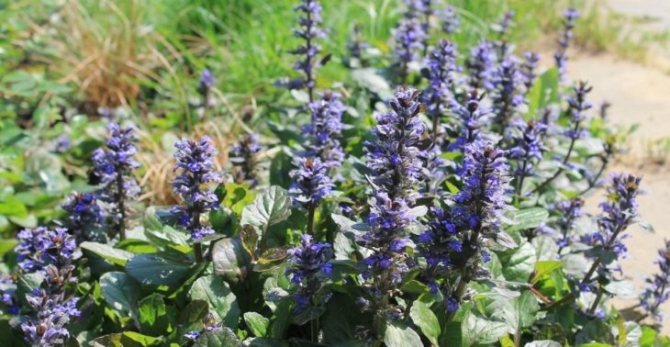

By dividing the rhizome
If it is necessary to transfer the plant to another site, it is convenient to use the method of dividing the rhizome. To do this, the dug out rhizome is divided into stolons so that each has 2-3 internodes. After that, they can simply be spread out on wet soil, without deepening in such a way that the apical bud is located at least 0.5 cm above the ground.
The method of dividing the rhizome is available only for the creeping tenacious and its variegated form "Rubra".
Bush rosettes
Ayuga can be propagated by dividing the bush into sockets. This can be done at any time, starting in early spring, the deadline is the second decade of September. The optimal planting material is "islands" of about 5 sq. Cm, formed from 3-5 outlets, but this is not always possible. If the material is limited (rare variety), single rosettes can also be used for planting. Moreover, even a damaged horse system, in the presence of even a small intact part (thread), is viable to give full-fledged offspring. As the outlets grow, they can be deposited continuously within the allotted period. They should be planted according to the 10-15 cm scheme.
The method is available for almost all types of tenacious and its varietal lines.
Variants of using the creeping and pyramidal tenacious in garden decor
There are many options for using this plant for decorating a garden. The fact is that the tenacious has a variety of shapes, covers the ground well, creates a contrasting background that favorably emphasizes other flowers.
Also read: Heliotrope: a colorful and aromatic guest from the tropics
At the same time, the plant can be used not only as an independent design tool, but also in combination with many other flowers and garden greens:
- The pyramidal tenacious has flowers of dark purple, blackberry shades; they are located on elongated narrow ears, which creates a good effect of striving in height. It can be used to frame different sectors of the garden, plant around the perimeter (this creates a beautiful floral border that highlights the contours of the site), as well as according to a pre-made pattern - for example, waves and zigzags.
- Small flower beds can be created from tenders, alternating with higher flowers in order to favorably emphasize both. The effect of contrast will manifest itself due to the differences in height, as well as due to the dark shades of the colors of the pyramidal tenon (or the green part of the Black Scallop plant).
- It is very beautiful to frame the flower beds from the tenacious with decorative roots of white shades. This looks especially appropriate when creating a flower garden in the style of a rock garden - the effect of snow-capped peaks on which flowers grow (for this you can plant plants on hills, hills).
- A very good decor option is to plant a tenacious animal on the shore of a summer cottage under taller plants. This creates the effect of a coastal forest with beautiful flowers along the pond.
- Ayuga can be grown next to conifers - together the composition will create the effect of movement, upward aspiration.
- Also, the tenacious looks harmoniously with ferns, which contrast with the shades of the leaves and at the same time are approximately on the same tier.
- An excellent combination is created by the tenacious iris, the bright flowers of which look good against the background of the solid green carpets of the Ayuga.
- Finally, the most versatile option is to plant the plant in all unused areas that look ugly due to blackening soil. It will cover all open spaces well and create an original green carpet effect.
Growing in the garden
Tenacious is a plant without any special whims. However, it is not recommended to abuse this factor.
Seat selection
There is no principle in choosing a site. The midday heat will not harm the plant. In rare cases, many flowers will delight you with their "fertility" if they are placed in a dense shade. This factor does not affect the vital activity of this garden decoration.
Heavy soils with high humidity are suitable as soil. If you want to choose a zone of maximum comfort for a plant, you can give preference to:
- humus-rich territory;
- wet loam;
- sliding shadow.
There is an option of sowing in the area of tree trunk circles. It will not hurt them, because it does not take food from the "neighbors".
Description
A short (up to 30 cm) perennial plant is a member of the Labiatae family. Its second name is Ayuga, which also looks attractive. Small flowers adorn the erect stem, which has spectacular wide leaves as an added bonus.
It is necessary to distinguish between the basic type of plant and its variations. In the main type, the flowers are colored blue. They can also have purple or yellow petals. Decorative varieties are pink or white flowers.
Sunny glades, deciduous forests and dense bushes are places where you can find the south.
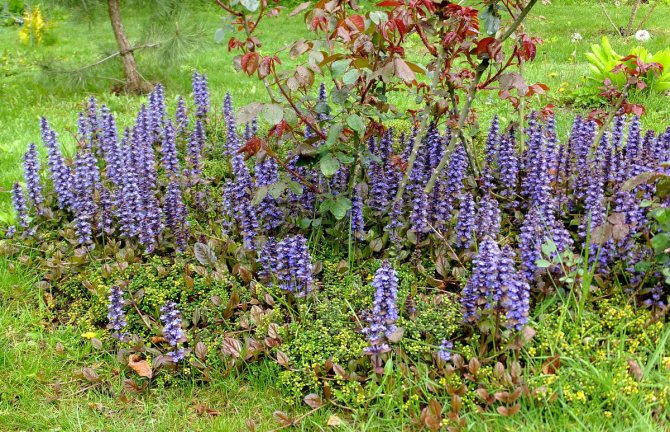

In Russia, such a plant is often called a non-wilting, Dubrovka, Dubnik, Nemirashka, or Vologda.
Caring for plants at home
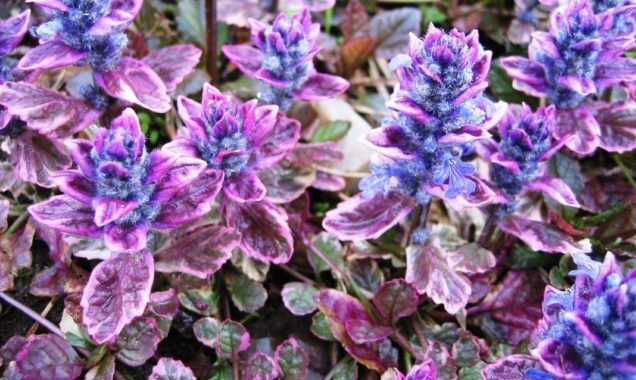

This hardy and really tenacious perennial can often be found on spacious meadows and forest glades in central Russia. Why is it interesting for gardeners? Its unsurpassed vitality and adaptability to almost any conditions and, of course, the fact that during flowering it turns not the most comfortable corners of the garden into pretty sky blue rugs. The name creeping grass also got the name for a reason - it easily spreads over the site, occupying empty spaces. In combination with easy and easy care, the flowers of the tenacious can be recommended for planting in large household plots if it is impossible or unwilling to cultivate the entire adjoining territory for gardening needs. Like any ground cover, the tenacious will perfectly fill the voids between other decorative or fruiting crops.
Necessary conditions for growing
Planting and caring for a tenacious outdoor plant is one of the easiest procedures even for novice gardeners. This plant does not suffer from a lack of illumination, tolerates a drop in temperature down to zero, undemanding to the composition of the soil.
Location and lighting
Plant varieties are selected based on the area to be covered. If you are planning on making a beautiful living carpet, place the crop in a bright, sunny spot. For areas in partial shade or shade, all varieties are suitable, except for the Polar Fox variety, which is more demanding on light.
The tenacious is not suitable as a lawn grass. The stems are soft, easily deformed and broken. It can destroy delicate primroses, it coexists well with garden trees, any shrubs.
You can also use it for landscaping large areas, retaining moisture in the near-stem zones of large trees.
Air humidity
Ayuga tolerates well the decrease in air humidity, which occurs at temperatures above +25 degrees. Moreover, the more humid the air is, the more green and juicy the parts of the plant - leaves and flowers - will be. You do not need to spray or water the flower additionally.Only if it begins to shed foliage, turns yellow, tilts to the ground, deforms, you can check the soil for the degree of moisture and do additional watering.
Soil requirements
Almost any soil is suitable for growing. The most active growth is noted on fertile light soil types, which can ensure the unhindered penetration of oxygen and moisture to the root system. During planting, add peat, fine sand, compost soil or rotted manure to the soil mixture.
The maximum height of fertile soil is 1.6 m, since the roots of the plant are small, this layer will be enough to receive the required amount of air and moisture, as well as nutrients.
Care features
The main phase of caring for the plant is the first month after planting the shoots in the ground. During this period, you need to water them abundantly in the morning or after sunset. If an illuminated bed is selected as an area, darkening may be required. Everyday watering is stopped as soon as the first leaves appear.
The need for watering
The soil in the near-root zone should always be moist, but not too much. Cracks must not be allowed to form on the soil surface. In this case, the earth, drying out, can break the roots and lead to the death of the plant.
Water so that the soil is always moist and loose. This will allow oxygen, nutrients and moisture to pass to each root and nourish the Ayuga.
You can use ordinary water, make sure that its temperature is not lower than +15 degrees. From cold water, the plant experiences stress, the aboveground parts soften, the stem tends to the ground.
Top dressing
This unpretentious plant actively develops even on depleted soils, survives in any climatic zone, and tolerates frost well. But in order for the culture to look beautiful and healthy, to have a high decorative effect, which is necessary in landscape design and when landscaping a plot, it is necessary to feed the flower 1-2 times a month during the vegetative phase.
Any universal top dressing is suitable, including organic, as well as peat oxidate. Expensive fertilizers are not required, you can use rotted manure, bird droppings.
Pests and diseases
The plant is resilient enough to repel attacks from numerous pests and protect itself from diseases. The main problem when grown in very wet soil and at low temperatures is slugs that come out at night and eat the succulent leaves. You can notice them with the naked eye, they leave traces along the edge of the sheet - small bites and holes.
Since slugs do not fly, you can get rid of them in a simple way without using insecticides. Around the perimeter of the flower bed, where the tenacious plant grows, a strip of coarse gravel or gravel 2-3 cm high is poured. This will be an obstacle for the pest.
Tenacious after flowering
Seed collection
As already mentioned above, it is pointless to collect seeds, since they are not able to preserve the varietal characteristics of the mother plant, and also because the tenacious reproduces well by self-sowing. Experienced gardeners are advised to cut off the testes, and use sockets for reproduction.
Wintering
If the winters are snowy, then the plant will be able to survive them without shelter. In the event that there is practically no snow in the winter, the plantings will need to be covered with dried foliage or spruce branches. Young bushes should be covered for the winter.
Features of the creeping tenacious
It is recommended to plant the tenacious between tall bushes, along paths, between stones. She herself is short (15-30 cm). The tenacious will quickly create lush pillows of luscious greenery and delicate small flowers.
- It is vitality that has become the hallmark of this plant. It will adapt to any conditions. If there is no drought, it may not be watered all year round.Until the very frost, Ayuga will not shed its leaves, delighting everyone with numerous shades from green to pink-purple.
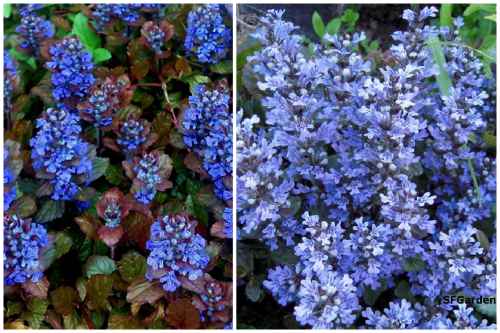

- Under natural conditions, the tenacious can be found in forest glades. It is a ground cover plant that can easily grow in the garden. In May-July, it pleases with delicate blue flowers. Be sure to plant this plant in your garden if you want to give it a natural look and beautify it. Ayuga is especially appropriate in large and medium-sized gardens. But in small areas and rock gardens it is necessary to limit its growth.
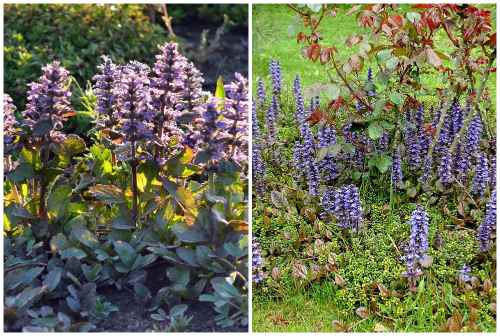

- There are deciduous varieties, there are evergreens. Florists most of all like species with shoots that can quickly fill the space. On wet soil, they take root quickly.
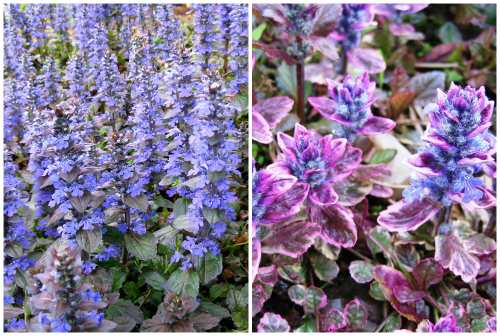

- It is important that the creeping tenacious tolerates the hottest summer days. She can live without watering for about a month without losing her attractiveness. She is not afraid of frosts. In this it fully justifies its name.
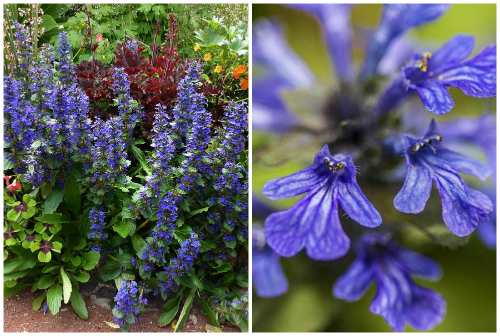

- If you choose the right planting site, the grass can grow for about 3-4 years.
Growing a tenacious plant from seeds
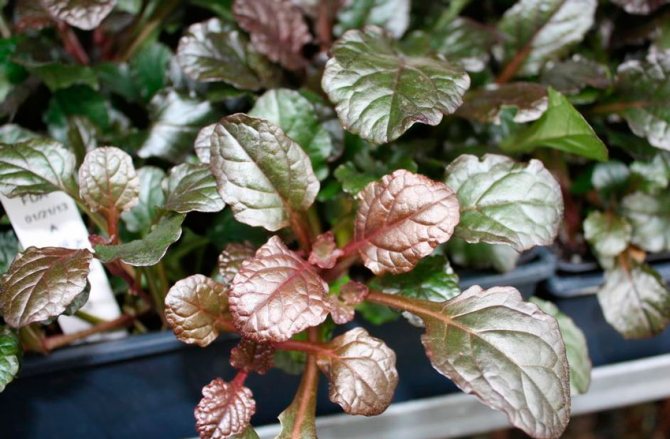

What time to sow seeds
Sow the seeds of the Ayuga directly into the open soil. If sowing is done for the first time, then the seeds can be purchased without any problems at a specialized store. Such seeds are highly germinating. Seeds are sown directly into open soil in spring, when it warms up properly. You can also sow Ayuga before winter in autumn. A suitable area should be well lit or shaded. Often, the tree trunk circle becomes the place for planting the tenacious. The fact is that this herb will not take away nutrients from the soil that the tree needs. Ayuga grows best on well-cultivated garden soil or on nutritious moist loam. Before starting sowing, the site must be dug up, while introducing organic matter into the soil (per 1 square meter from 10 to 15 kilograms) and a complex mineral fertilizer or double superphosphate (per 1 square meter, 100 grams).
How to plant correctly
If desired, in the store you can buy ayuga seedlings, which are sockets. They are planted in open soil from mid to late May. Such grass is not afraid of short frosts down to minus 8-10 degrees. For planting seedlings, you should choose a sunny, dry day. A distance of 0.25–0.3 m must be kept between the bushes. The growth point must necessarily remain above the ground surface. The land near the bushes must be tamped. The planted plants need abundant watering, while trying not to expose the roots.
Reproduction methods
The culture propagates in two ways:
- Seminal. Only used if this is your first time growing a plant. Varietal species that are grown from seeds harvested after flowering in the garden will not have the characteristics of the parent species. If a tenacity is already growing on the site, then it is easier to propagate it with the help of sockets.
- Vegetative propagation by rosettes carried out either in early spring, or until the second half of September. The sockets are carefully planted by digging out their root system. One by one or in a whole group, transfer them to a new site, having previously prepared the soil. A rosette with even one small spine may well take root in a new area.
Planting outlets is carried out at a distance of at least 15 cm between shoots, if the procedure is carried out annually. If you do reproduction less often, then leave gaps of at least 25 cm.When the shoots are fully rooted, new leaves begin to appear and the length of the bush increases, stop daily watering.
In addition, this unpretentious culture can reproduce on its own. Self-seeding occurs after the end of flowering and seed ripening. But in this case, varietal characteristics of many species are lost.To prevent this from happening, peduncles must be removed as they grow in flowering species, and in those that do not bloom - at the time of the emergence of a flower shoot. The process is quite laborious, it requires skills and the use of special tools. But in this way you can preserve the characteristics of the species.

